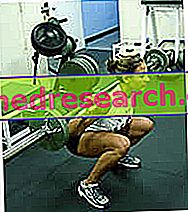by Alessandro Stranieri
Published on n. 30 of HiTech Volleyball - September 2004
In sport the forms in which the capacity for strength is manifested are multiple and different. Jumping, throwing, running, are all terms commonly used by athletes of different disciplines, but few of them would think of the gestures mentioned as a particular expression of strength.
Definition of strength
The motor capacity of strength is usually referred to as the ability of a subject to oppose or overcome a resistance by means of a muscular contraction.
In physics, this is expressed with the formula F = M a, that is M assa x with cceleration. Applying this concept to sports movements, it can be deduced that, for the same force used, the greater the mass, the lower the acceleration imparted to the body. This means that, between two people with a hypothetical lower limb musculature of equal development, the less heavy will jump higher. This assumption is one of the reasons that explain why volleyball players have excellent muscular tone for jumping and not hypertrophic and heavy like a bodybuilder.
The ability to force, therefore, is generally always present, expressing itself each time in different ways and in conjunction with the other conditional abilities ( speed, resistance ). Every sport has its own particular need for strength ( maximum strength, resistant strength, fast strength ) on the basis of which the ideal training schedule must be determined for the right muscle level of the athlete.
Team sports, in particular, require a specialization of the neuro-muscular apparatus in order to improve the ability to develop high strengths in a very short time, followed by an improvement in the coordination of movements during high and rapid commitments of strength.
Fundamentally, strength training programming generally pursues some main goals, including:
Improvement and maintenance of muscular fitness for the purpose of performance;
Muscle-tendon and bone enhancement for the evolution of the stability of the musculoskeletal system, depending on the high specific loads;
Compensation of the less used muscle groups in the peculiar technical gesture of each sport.
Training methods
Strength-related muscle strengthening is generally imparted with isotonic (dynamic) or isometric (static) methods. In the first case, the affected muscle shortens during the active phase of the movement (concentric phase), gradually releasing itself later during the passive phase (eccentric phase), to return to its original length.
Static methods include exercises in which the muscle makes a contraction while maintaining its length and the distance between the joint heads. Between the two models, the isotonic is however the most used and easily applicable.
Exercises and means
Strength training for the lower limbs is distinguished in 2 different types of exercises:
closed kinetic chain (CCC) such as the Squat and thrusts to the Leg Press, in which the feet are bound to the thrust plane;
open kinetic chain (CCA) such as the Leg Extension, which does not provide a constraint on the ends nor the movement of the other segments ( thigh, pelvis, trunk ).
Squat
This is the most complete exercise for acquiring the strength of lower limbs. The attitude of the body during the exercise in free-form with a barbell is very similar to the pushing movements made by the athlete during jumps.

The only disadvantage of this exercise (provided it is correctly performed) is the weight of the bar that presses longitudinally on the spine. In this regard, the Leg press exercises can be used to partially eliminate the load on the spine during execution.
Often, due to a reduced excursion of the ankle joint, retraction of the soleus or difficulty in anteroversion of the pelvis, some athletes fail to perform an exact bending of the legs without raising their heels and adopt a thickness under the heel to facilitate the correct alignment of all body segments. Personally I do not agree with this practice, either because it shifts body weight too far, by excessively loading the structure of the knee, or because it does not encourage a search for improvement in the articular range by the athlete. Also in this case the execution of the push to the Leg Press can be helpful to the problem, mainly because, apart from the differences in the involvement of the upper body, in the two exercises the involvement of the muscles of the lower limbs is substantially equal.
Indications for the correct execution of the exercise
Begin the descent by moving the pelvis backwards, as in the movement of sitting on a chair. In this way the knees will not move forward but will remain perpendicular to the foot.
The tips are slightly turned outwards and hint at a "V". Do not look for further intra or external rotations of the feet believing that you are emphasizing some muscles: it is harmful and above all useless.
Keep your back well aligned and stretched during descent and ascent, looking forward-upward.
 Copyright protected image |
During strengthening programs, try to use overloads without subjecting the joint and ligaments of the knee to excessive stress. In the drawing it is possible to observe the different load to which the knee is subjected during two different types of exercise for the lower limbs: Leg extension (CCA-open kinetic chain), Leg press / Squat (CCC-closed kinetic chain). During the extension of the knee to the leg extension a cutting force component develops. The figure shows how the vector of force impressed by limb (a) crosses the vector of the direction of resistance opposed by the ligaments (b) at a point (C) outside the system of action of the leg, which is subjected to resistance (R ) represented by the machine bearing. In this situation there is a forward translation of the tibia and a slide in the back of the femur (anterior drawer), prevented by the resistance offered by the ligaments (86% for the ACL). In Leg Press, on the other hand, the intersection point (C) is located inside the "system" creating a much shorter lever arm (aC) and a lower cutting force, and in this case, the ischiocrural muscles are activated and reduce the phenomenon of the anterior drawer by attenuating the stress on the LCA. In the squat as in the leg press, it is good practice to respect a correct alignment between foot and knee as shown by the green arrow. |
Leg Extension
It is another excellent exercise for the musculature of the leg extensors. In addition to not aggravating the already heavy load of the intervertebral discs, it allows a more selective training of the muscles that make up the femoral quadriceps, especially the medial and lateral ones ( both in the Squat and in the Leg Extension, the femoral rectum is the least involved in as partially "detained" due to the inclination of the trunk forward and the consequent hip flexion ).
Here too there is the possibility of a structural overload, this time however, at the expense of the anterior cruciate ligament (LCA), particularly stressed in this exercise especially during the last 40 ° of knee extension (see box). For this reason it is advisable to use the Leg Extension with loads that are not too high, such as for example a general muscular work with a high number of repetitions.
Indications for the correct execution of the exercise
Do not start the extension movement from a starting position to an excessively flexed knee;
Do not bring the knee into hyper-extension in the final phase; some machines have the ability to adjust working angles.
Do not remove the buttocks and loins from the seat during the outward and return phases of the movement;
In conclusion
Although the rather recent studies by Moore and Beynnon disagree on the lower danger to the LCA, in general we can say that, if well executed, the closed kinetic chain exercises, in particular the free barbell squat, are less harmful to the knees compared to those in the open kinetic chain, also bringing a series of further positive sides such as:
Best simulation of the athletic jump gesture;
Greater protection of the LCA by simultaneous intervention of quadriceps and ischiocrural;
Lower stress of the patellofemoral joint;
Greater stability due to the compression given by the forces acting;
A major hormonal response that has a positive impact on the strengthening of the muscle-tendon and bone systems.
(For further information on the subject you can consult the works of authors such as: Henning, Nisell, Yasuda, Renstrom, Grabiner, Markolf, Lutz, More, Pope, Escamilla, Wilk, Bosco).
 | Alessandro Stranieri Personal Fitness Trainer www.stranieri-fitnesstrainer.it |



